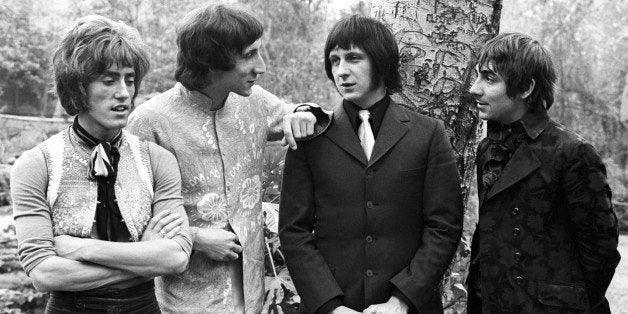
The Wrecking Crew, a much-needed documentary about the behind-the-scenes elite crop of studio musicians who provided the instrumentation for many of the hits of the 1960s, has been shown on the festival circuit and has recently received completion funds. In addition to providing the backing for solo artists, studio musicians often augmented existing groups or replaced them entirely during recordings. When music fans saw their favorite rock groups miming to their records on TV, they didn't know that often the performers hadn't played on them. Dick Clark, the producer and host of American Bandstand, wasn't aware, either, as he reveals in the film's trailer: "I had no idea that people didn't play on their own records until the Monkees came along." What follows is a sampling of well-known hits from the Sixties, with the date the record entered Billboard magazine's chart.
THE BEACH BOYS "I Get Around" (5-23-64)
The Beach Boys (Brian Wilson, Carl Wilson, Dennis Wilson, Al Jardine, Mike Love -- lead vocal on this song) sang on the record, but the backing tracks were provided by studio musicians.
Jerry Cole, guitar; Bill Pitman, guitar; Ray Pohlman, bass; Leon Russell, piano; Hal Blaine, drums; Steven Kreisman, sax; Jay Migliori, flute.
THE KINKS "You Really Got Me" (9-26-64)
The Kinks: Ray Davies, lead vocals; Dave Davies, guitar; Pete Quaife, bass.
Assisted by Bobby Graham, drums; Arthur Greenslade, piano.
Group drummer Mick Avory was relegated to tambourine.
THE WHO "I Can't Explain"
The Who's first record, recorded in November 1964, made the Top 10 in Britain, selling 109,000 copies. Roger Daltrey, lead vocals; Pete Townshend, guitar; John Entwistle, bass; Keith Moon, drums. Assisted by Perry Ford, piano; The Ivy League (Perry Ford, John Carter, Ken Lewis), harmony vocals.
HERMAN'S HERMITS "Silhouettes" (4-3-65)
Lead singer Peter Noone provided the lead vocals on this January 1965 recording.
The other band members (Derek Leckenby, Karl Green, Keith Hopwood, Barry Whitwam) didn't play.
Vic Flick, guitar; Big Jim Sullivan, guitar; John Paul Jones, bass; Bobby Graham, drums; John Carter & Ken Lewis, backing vocals.
(Vic Flick played the distinctive guitar melody on the original "James Bond Theme" which debuted in Dr. No.)
THE BYRDS "Mr. Tambourine Man" (5-15-65)
When the Byrds' manager Jim Dickson brought the group this unreleased Bob Dylan song, they initially refused to record it because they considered it uncommercial. For the January 1965 recording, producer Terry Melcher suggested a rhythmic feel similar to the Beach Boys' "Don't Worry Baby."
Among the Byrds, Jim McGuinn (later "Roger") sang the lead and Gene Clark and David Crosby supplied the harmonies. Bassist Chris Hilman and drummer Michael Clarke weren't on the record. McGuinn is the only Byrd who played on the song and the "B" side of the single "I Knew I'd Want You" (Gene Clark lead vocal).
Bill Pitman, guitar; Jerry Cole, guitar; Jim McGuinn, guitar; Larry Knechtel, bass; Leon Russell, piano; Hal Blaine, drums.
THE YARDBIRDS "For Your Love" (3-5-65)
Keith Relf, lead vocal; Eric Clapton, guitar; Chris Dreja, guitar; Paul Samwell-Smith, bass; Jim McCarty, drums.
Assisted by Ron Prentiss, acoustic bass; Brian Auger, harpsichord; Denny Piercey, bongos.
THE STRANGELOVES "I Want Candy" (6-26-65)
Producers/songwriters Bob Feldman, Richard Gottehrer and Jerry Goldstein provided the vocals.
Session musicians: Eric Gale, guitar; John Shine, bass; Herb Lovelle, drums; Richie Lauro, sax
The song was inspired by Terry Southern's novel Candy.
THE MONKEES "The Last Train to Clarksville" (9-10-66)
The first single issued to promote the fall 1966 TV show starring Micky Dolenz, Davy Jones, Mike Nesmith and Peter Tork, only features Dolenz, on lead vocals.
Recorded in July 1966, the instrumental backing was provided by members of producers Tommy Boyce and Bobby Hart's band, the Candy Store Prophets: Tommy Boyce, acoustic guitar; Gerry McGee, guitar; Larry Taylor, bass; Billy Lewis, drums.
Assisted by Wayne Erwin, guitar; Louie Shelton, guitar; Gene Estes, percussion.
In an interview that ran in the January 1967 issue of The Saturday Evening Post, Mike Nesmith expressed his extreme frustration that the Monkees were prevented from playing on their records. Prior to this outburst nobody had an inkling that the musicians pictured playing instruments on their album covers might not have played on the records.
THE GRASS ROOTS "Let's Live For Today" (5-13-67)
Group members Creed Bratton and Warren Entner contributed the guitars and background vocals; bassist Rob Grill the lead vocal. Neither Grill or drummer Rick Coonce played.
Assisted by Bobby Ray, bass; Hal Blaine, drums.
The group's album, issued three months later, broke new ground in crediting the non-band members who contributed to the recording.
DONOVAN "Hurdy Gurdy Man" (6-22-68)
Donovan, lead vocals, acoustic guitar; Alan Parker, guitar; John Paul Jones, bass; Clem Catini, drums.
It should be pointed out that in many cases the musicians who comprised the various bands were capable of recording in the studio, but it would take them much longer to learn the songs and perform them than the crack studio musicians. Peter Noone and the Raiders' Mark Lindsay provided some perspective in separately pointing out to me that a band made most of its money from live performances, and time taken away from tours to record in the studio would have cost the band money.
Harold Bronson's book THE RHINO RECORDS STORY was recently published.